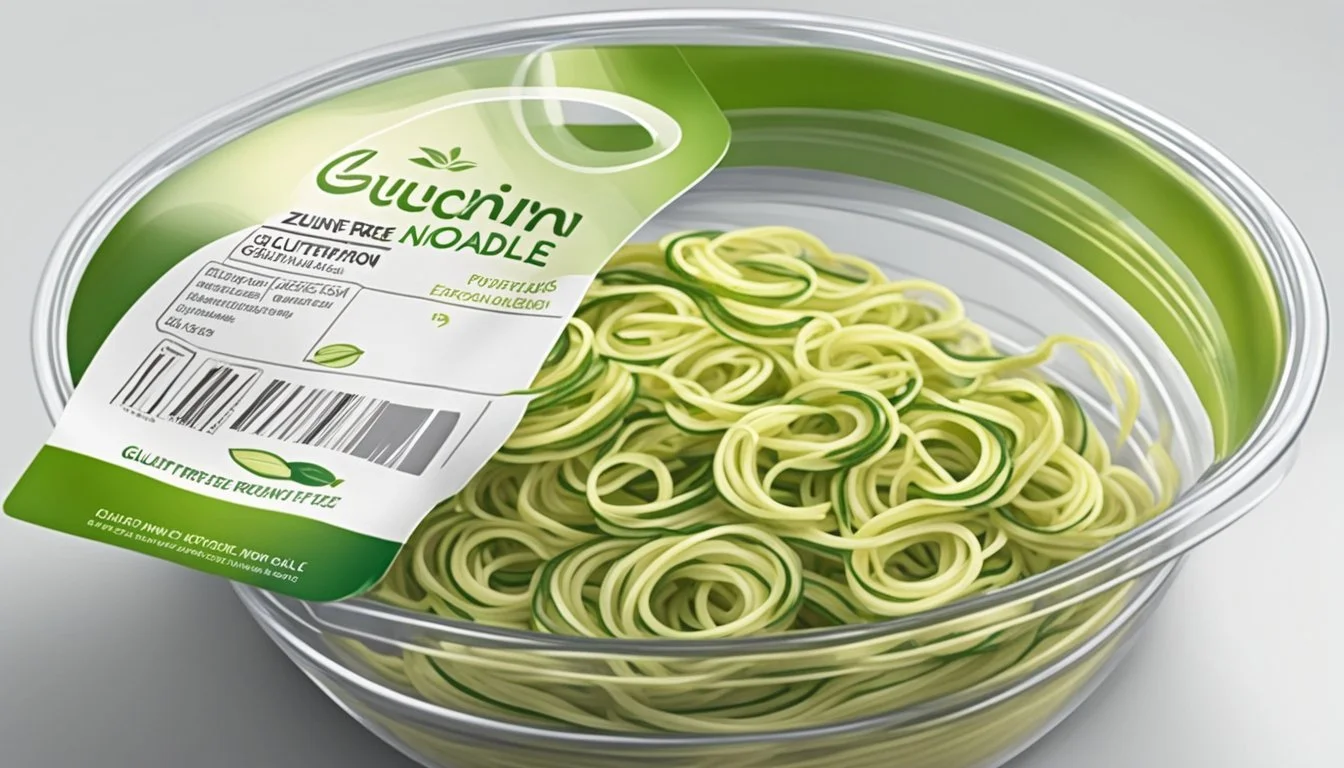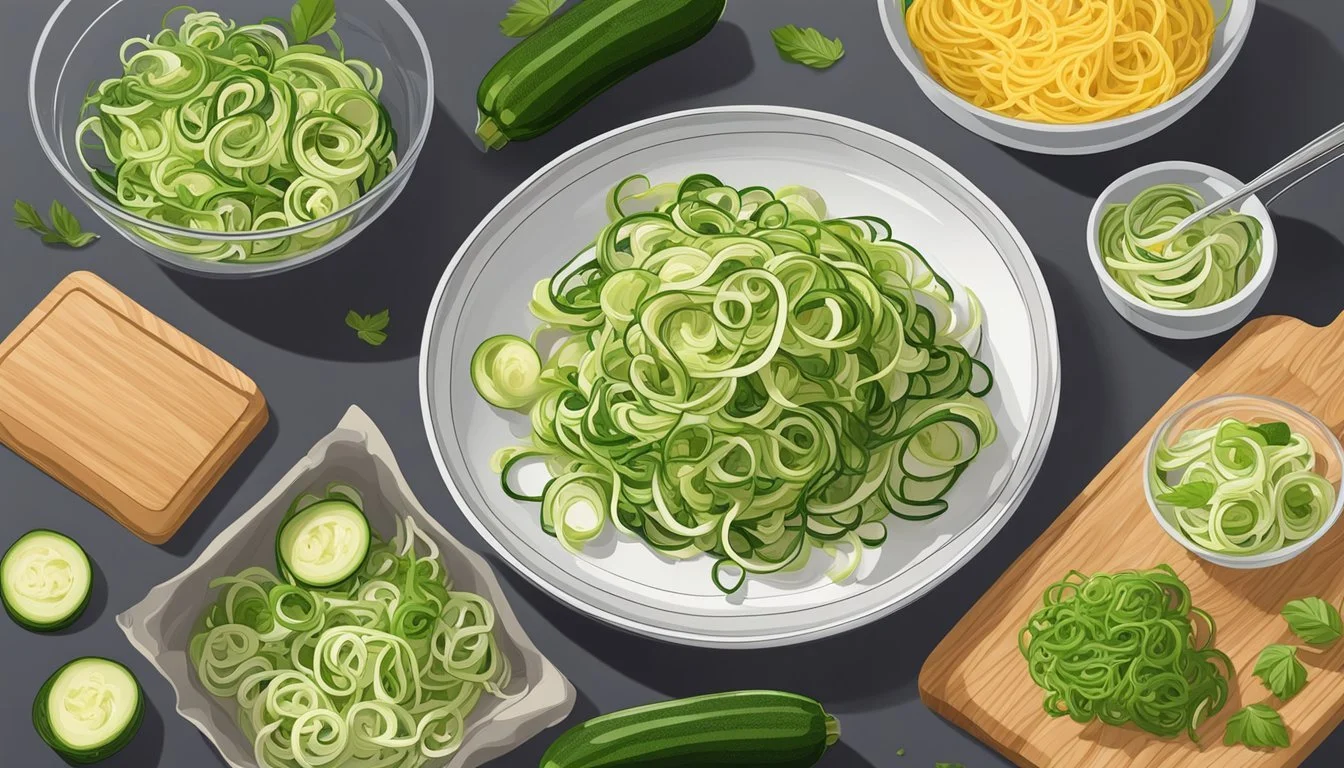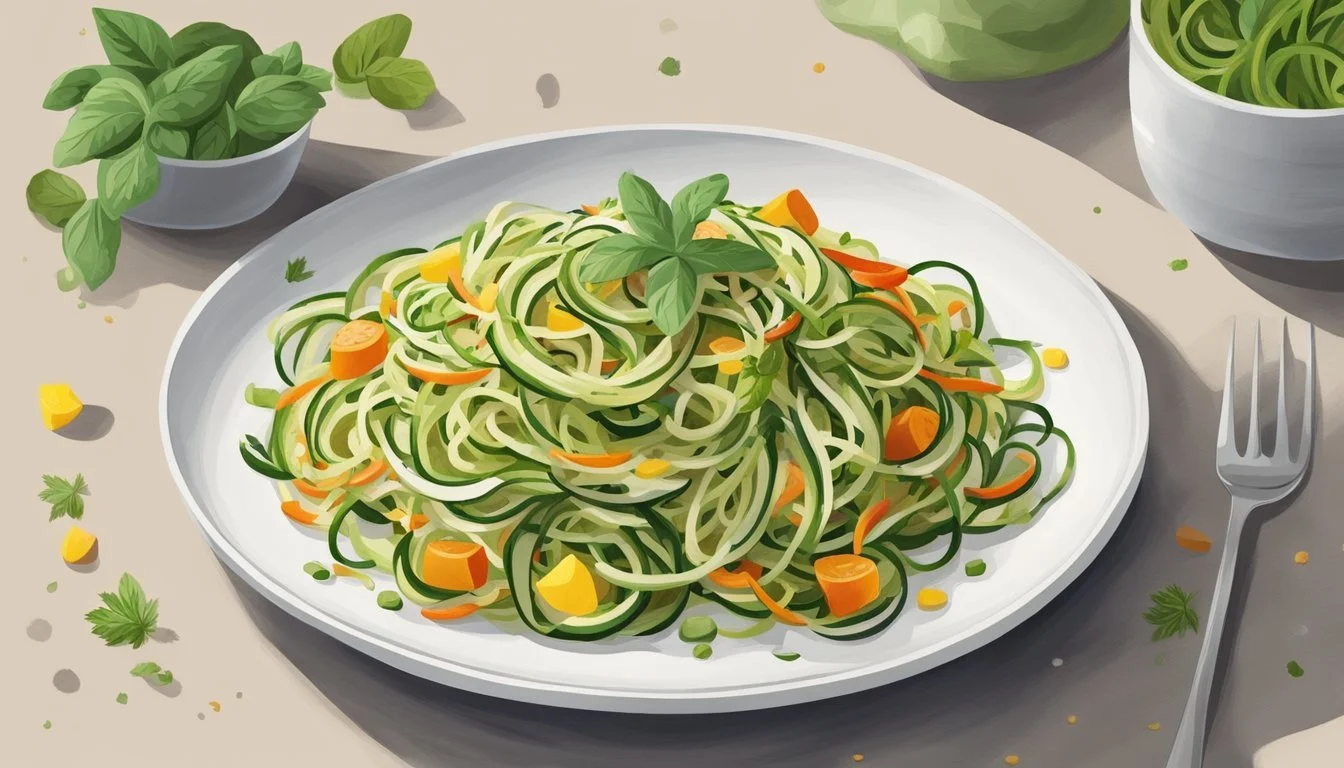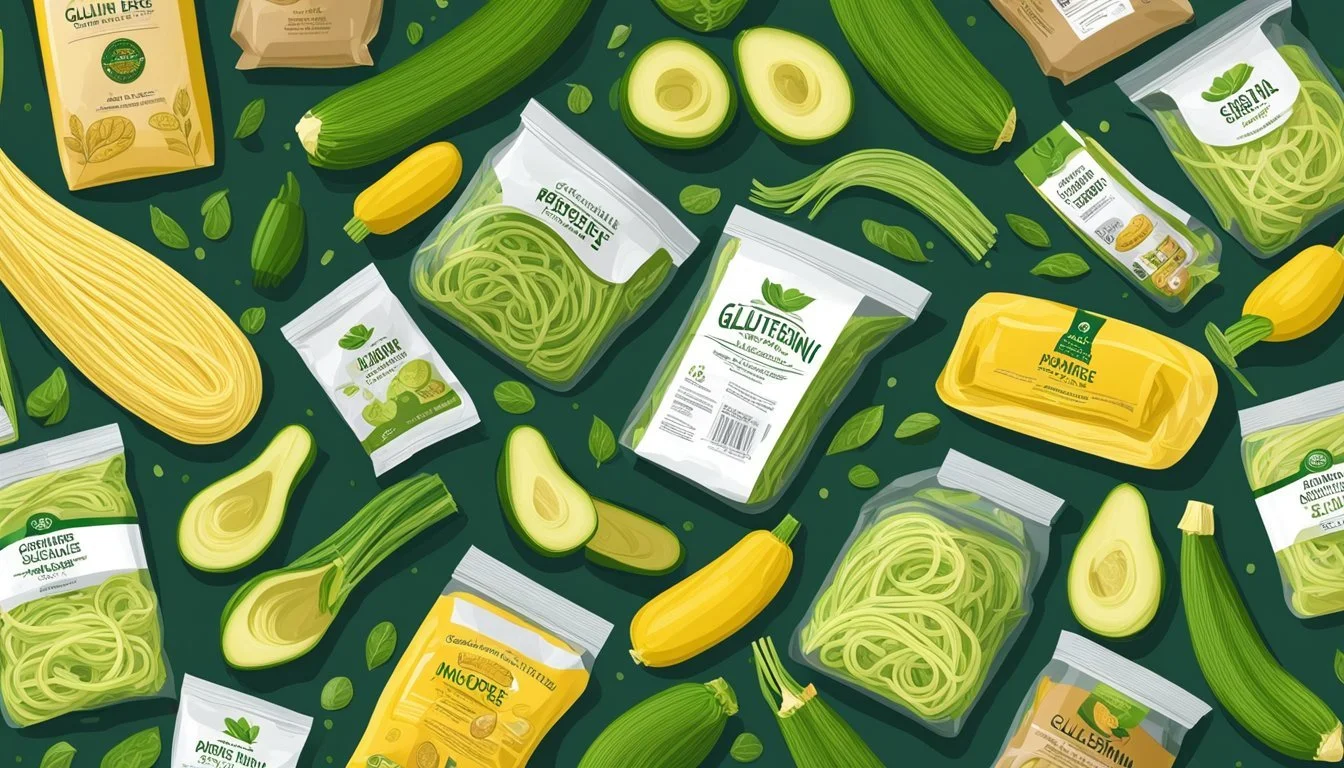How Long Do Gluten-Free Zucchini Noodles Last?
Freshness Guide
Zucchini noodles, often called zoodles, are a fantastic gluten-free alternative to traditional pasta. Rich in nutrients and low in calories, they are a favorite among health-conscious individuals looking for a nutritious and tasty meal. When stored properly, gluten-free zucchini noodles can last up to 3-5 days in the refrigerator. This makes them not only a healthy option but also a convenient one for meal prep.
Knowing how to store zoodles effectively is key to maintaining their texture and flavor. It's important to keep them dry and separated from any sauce until just before serving, as moisture can cause them to spoil faster. Freezing them is another option, but take care to flash-freeze them and store them in individual portions to avoid sogginess.
The versatility of zucchini noodles allows for great creativity in the kitchen. They can be paired with a variety of sauces and ingredients, making them a staple in gluten-free and healthy cooking. The combination of their long shelf life and nutritional benefits turns them into an essential item for anyone looking to make better dietary choices.
Understanding Zucchini Noodles
Zucchini noodles, also known as zoodles, are a popular alternative to traditional pasta due to their low carbohydrate content and gluten-free nature. This section explores what zucchini noodles are, their nutritional benefits, their advantages for those avoiding gluten, and how they compare to traditional pasta. Additionally, it discusses tools for making zucchini noodles.
What Are Zucchini Noodles?
Zucchini noodles are thin strands made from zucchini, often using tools like a spiralizer, mandoline, or julienne peeler. These "noodles" can replace traditional pasta in many dishes, offering a lighter, more vegetable-rich option. Zucchini noodles can be eaten raw or lightly cooked, retaining a firm but tender texture. They are versatile and can be paired with various sauces and ingredients.
Nutritional Profile of Zucchini Noodles
Zucchini noodles are low in calories, with approximately 19-20 calories per cup. They are low in carbohydrates, containing about 4 grams per cup, making them suitable for low-carb diets.
Additionally, zucchini noodles are rich in vitamins A and C, as well as potassium and antioxidants. They also provide small amounts of calcium, which is beneficial for bone health. This nutritional profile makes them a healthy alternative to traditional pasta, especially for those looking to reduce calorie and carbohydrate intake.
Gluten-Free Benefits of Zucchini Noodles
For individuals with celiac disease or gluten intolerance, zucchini noodles offer a safe and nutritious alternative to gluten-containing pasta. Since zucchini is naturally gluten-free, it eliminates the risk of gluten contamination.
This makes zucchini noodles an excellent option for those on a gluten-free diet. Moreover, they provide a mix of nutrients while being easy to digest, unlike some gluten-free pasta alternatives that may contain multiple grains and additives.
Comparison With Traditional Pasta
Comparing zucchini noodles to traditional pasta, the most notable difference is the carbohydrate content. Traditional pasta usually has around 43 grams of carbs per serving, while zucchini noodles have about 4 grams per cup. This significant reduction is beneficial for those on low-carb or diabetic diets. In terms of calories, traditional pasta contains roughly 200 calories per serving, compared to the 20 calories in zucchini noodles.
Furthermore, traditional pasta can be heavier and more filling due to grain content, while zucchini noodles are lighter, leading to a different eating experience. Despite these differences, zucchini noodles can often be used in recipes that call for pasta, making them a versatile substitute.
Popular Tools for Making Zucchini Noodles
The most common tool for making zucchini noodles is the spiralizer. This device allows users to create long, spiral-shaped noodles quickly. Spiralizers come in various sizes, from handheld models to larger countertop versions.
Another option is the mandoline slicer, which can cut zucchini into thin, uniform strips. Julienne peelers can also be used to create small, matchstick-like noodles. Each tool offers different textures and thicknesses, allowing for a variety of culinary uses. These tools make it easy for anyone to include zucchini noodles in their diet, enhancing both the nutritional value and the appeal of their meals.
Preparing Zucchini Noodles
Creating zucchini noodles involves selecting the right zucchini, spiralizing it correctly, managing prep time, incorporating flavors with added ingredients, and reducing excess moisture for optimal texture and taste.
Choosing the Right Zucchini
Selecting firm, straight zucchinis with vibrant green skin is essential. Look for zucchinis that are free from bruises or soft spots. Avoid those that are overly large, as smaller zucchinis tend to have a better texture for noodles. Tip: Consistency in size helps ensure the noodles cook evenly.
Steps for Spiralizing
To spiralize, cut off both ends of the zucchini. Using a spiralizer, place one end of the zucchini into the holder and the other into the blade end. Turn the handle to create long, even noodles. If you prefer shorter strands, cut the noodles to your desired length.
Optimal Prep Time for Quality
To maintain freshness, spiralize zucchini noodles as close to cooking time as possible. Prepped noodles can be stored in a sealed container in the refrigerator for up to 2-3 days. Tip: Laying the noodles on a paper towel before storing helps absorb excess moisture.
Additional Ingredients for Flavor
Enhance your zucchini noodles with ingredients like olive oil, minced garlic, and fresh herbs such as parsley. For added zest, squeeze some lemon juice over the noodles. Season with salt and pepper. Tip: Sauté the garlic in the olive oil for about 30 seconds before adding the noodles to infuse the flavors.
Techniques to Reduce Excess Moisture
Zucchini has high water content, which can lead to soggy noodles. To reduce excess moisture, sprinkle the noodles with salt and let them sit for about 10-15 minutes. Then, use a paper towel to pat them dry. Tip: Briefly sautéing the noodles instead of boiling helps maintain a firmer texture.
Cooking Methods and Techniques
Proper cooking techniques are essential to make sure gluten-free zucchini noodles maintain their texture and nutritional benefits. Whether sautéing for a perfect al dente texture or leaving them raw, each method provides unique advantages.
Sauteing for Al Dente Texture
Sautéing zucchini noodles is a popular method for achieving a firm, al dente texture. Start by heating olive oil and butter in a large skillet over medium heat. Add minced garlic and sauté for 30-60 seconds until fragrant. Then, add the zucchini noodles and toss them for 1-2 minutes. It's crucial not to overcook to prevent the noodles from becoming mushy.
These sautéed zucchini noodles can be enhanced with grated Parmesan cheese, which adds flavor and a slightly creamy texture. This method complements many sauces and toppings, making it versatile for various recipes.
Raw Preparation for Maximum Nutrition
For those looking to maximize the nutritional benefits of zucchini, serving them raw is an excellent option. Raw zucchini noodles maintain their vitamins, minerals, and enzymes better than cooked ones. Simply spiralize the zucchini into noodles and rinse them under cold water before patting dry with a clean towel.
Because raw noodles have a firmer texture, they pair well with lighter dressings and sauces. A simple combination of olive oil, lemon juice, salt, and pepper can create a refreshing dish. Raw preparation is ideal for salads and cold dishes, offering a crisp and fresh taste.
Pairing With Sauces and Toppings
Pairing zucchini noodles with the right sauces and toppings can elevate the dish significantly. Light, watery sauces can keep the noodles from getting soggy. Classic options include marinara, pesto, and creamy Alfredo. Sautéed zucchini noodles with a clam sauce can be a gourmet choice, blending flavors like garlic, parsley, and a splash of white wine.
Toppings such as grilled vegetables, crumbled feta or Parmesan cheese, and nuts like pine nuts or almonds add texture and flavor diversity. Experimenting with different combinations can help discover new favorite recipes, making zucchini noodles a versatile ingredient in any gluten-free kitchen.
Storage Solutions
Proper storage of gluten-free zucchini noodles ensures they remain fresh and edible for an extended period. Utilizing refrigeration, freezing, and dehydrating can significantly impact their longevity.
Refrigeration Best Practices
To maximize freshness, zucchini noodles should be stored in an airtight container.
First, place a paper towel in the bottom of the container to absorb excess moisture. This step is crucial because zucchini releases water as it sits. Fill the container with noodles and add another paper towel on top before sealing the lid tightly.
Store in the refrigerator, preferably in the crisper drawer, to maintain slight humidity, which prevents drying. Usually, refrigerated zucchini noodles stay fresh for 3-5 days.
Can Zucchini Noodles Be Frozen?
Yes, zucchini noodles can be frozen to extend their shelf life.
Before freezing, blanch the noodles by boiling for a brief period and then plunging them into ice water. This process helps preserve their color and texture. Once blanched, drain thoroughly using a colander to remove excess moisture.
Store the noodles in a freezer-safe, airtight container or vacuum-sealed bag. Frozen zucchini noodles maintain optimal freshness for about 2-3 months, although they can last up to 8 months.
Extending Shelf Life Through Dehydrating
Dehydrating zucchini noodles is an effective way to extend their shelf life.
Start by spreading the noodles on a dehydrator tray, ensuring they are not overlapping. Set the dehydrator to around 125°F and let it run for several hours until the noodles are completely dry and brittle.
Once dehydrated, store the noodles in an airtight container or vacuum-sealed bag to keep them dry. Dehydrated zucchini noodles can last for several months when stored in a cool, dry place, making them an excellent long-term solution.
Serving Suggestions
Zucchini noodles, or zoodles, are versatile and can seamlessly fit into various meals. They're often paired with different sauces, meats, and vegetables, making them a great option for both lunch and dinner.
Creative Ideas for Zoodle Dishes
Zoodles can replace traditional pasta in spaghetti dishes. Try pairing them with a savory tomato sauce and meatballs for a hearty meal. Another popular option is tossing zoodles in a creamy alfredo sauce, adding grilled chicken or shrimp for a protein boost.
For a lighter dish, combine zoodles with a pesto sauce and roasted vegetables. Adding a handful of cheese, like Parmesan, can enhance the richness. Those who prefer Asian flavors can stir-fry zoodles with soy sauce, ginger, and sesame oil for a quick and easy meal.
Incorporating Zoodles into Lunch and Dinner
Zoodles make an excellent lunch, especially in salads. Mix zoodles with grape tomatoes, cucumbers, and a light vinaigrette for a refreshing meal. For added texture, sprinkle nuts or seeds on top.
Dinner options include using zoodles as a side dish alongside a protein such as grilled salmon or steak. They can also be baked in casseroles, combining them with cheese and vegetables for a comforting dish. Adding a kick with a spicy marinara sauce can make dinner more exciting.
Ultimately, the simplicity and adaptability of zoodles make them ideal for a variety of savory, salty, and easy recipes. Their ability to work well with an array of ingredients makes them a favored choice for health-conscious individuals.
Health and Dietary Considerations
Gluten-free zucchini noodles offer various health benefits, especially for those following low-carb diets or managing digestive health and allergies. They provide a nutritious alternative to traditional pasta.
Weight Management and Low-Carb Diets
Zucchini noodles are an excellent choice for weight management. They are naturally low in carbs and calories, making them ideal for those on ketogenic or other low-carb diets.
One cup of zucchini noodles contains about 20 calories compared to approximately 200 calories in an equivalent serving of wheat pasta. This significantly lower calorie count helps maintain a calorie deficit, which is crucial for weight loss.
Because they are gluten-free, zucchini noodles are also suitable for people with gluten sensitivities or Celiac disease. By substituting traditional pasta with zucchini noodles, individuals can enjoy a satisfying meal without gluten, aiding in better overall health.
Allergies and Digestive Health
Zucchini noodles are beneficial for people with gluten allergies and digestive issues. Traditional pasta often contains gluten, which can cause adverse symptoms for those with Celiac disease or gluten sensitivities. Zucchini noodles provide a safe and delicious alternative.
They are also rich in dietary fiber, which promotes digestive health. Fiber helps maintain regular bowel movements and prevents constipation. Consuming zucchini noodles can enhance the efficiency of the digestive system.
Additionally, zucchini is known for its high water content and essential nutrients such as vitamins A and C, which support overall health. The ease of digestion and nutrient density make zucchini noodles an excellent choice for those seeking a healthier, gluten-free pasta alternative.
Community and Resources
For those looking to explore the world of gluten-free zucchini noodles, there are numerous online communities, cookbooks, blogs, and product recommendations available. These resources provide valuable tips, inspiration, and reviews to enhance your cooking experience.
Online Communities and Social Sharing
Online platforms like Instagram, Pinterest, and Facebook host vibrant communities that share gluten-free recipes. On Instagram, hashtags such as #zoodles and #glutenfree provide a wealth of visual inspiration and user experiences. Pinterest boards dedicated to gluten-free cooking feature an extensive array of zucchini noodle recipes. Facebook groups allow users to engage, ask questions, and share their personal tips and tricks for storing and cooking zucchini noodles.
Cookbooks and Blogs
Numerous cookbooks and blogs provide detailed guidance on gluten-free zucchini noodles. Bloggers often share personal stories, step-by-step recipes, and images that make the cooking process more accessible. Titles from well-known culinary figures within the gluten-free, vegan, and Whole 30 communities are readily available. These resources help in discovering new uses for zucchini noodles and improving storage techniques to ensure maximum freshness.
Product Recommendations
Investing in the right kitchen tools can significantly enhance the preparation of gluten-free zucchini noodles. Spiralizers, such as those from Paderno World Cuisine, make noodle creation straightforward and efficient. Reliable storage solutions, available on Amazon.com, help maintain the freshness of prepared noodles. By participating in the Amazon Services LLC Associates Program, one can find and recommend products that fit specific dietary needs, helping others make informed decisions about their kitchen investments.
Each of these elements contributes to a more fulfilling and effective gluten-free cooking journey, especially where zucchini noodles are concerned.
Frequently Purchased Alternatives
People often seek substitutes for zucchini noodles in gluten-free and low-carb diets. Several alternatives stand out for their health benefits and versatility.
Carrot Noodles
Carrot noodles are a popular substitute. They offer a slightly sweet flavor and vibrant color. A spiralizer or julienne peeler can easily transform carrots into noodles.
Spaghetti Squash
Spaghetti squash forms natural strands when cooked. It's gluten-free and can be used in a variety of dishes, mimicking the texture of traditional pasta.
Sweet Potato Noodles
Sweet potato noodles are another excellent option. They provide a different texture and a rich, slightly sweet taste. A spiralizer is useful for creating even, long strands.
Cucumber Noodles
Cucumber noodles, often called "cukoodles," are ideal for cold dishes. They add a refreshing crunch and are easy to make with a mandoline or spiralizer.
Shirataki Noodles
Shirataki noodles come from the konjac root. They're low in carbs and calories, ideal for those looking for a neutral-flavored pasta substitute.
Butternut Squash Noodles
Butternut squash noodles offer a nutty flavor and can be used in both savory and sweet dishes. They require a sturdy spiralizer due to their firm texture.
Carrots, sweet potatoes, and spaghetti squash are particularly notable for their nutritional benefits and ability to be spiralized or julienned into noodle-like forms.
Consider these alternatives when looking for variety in gluten-free noodle dishes.









